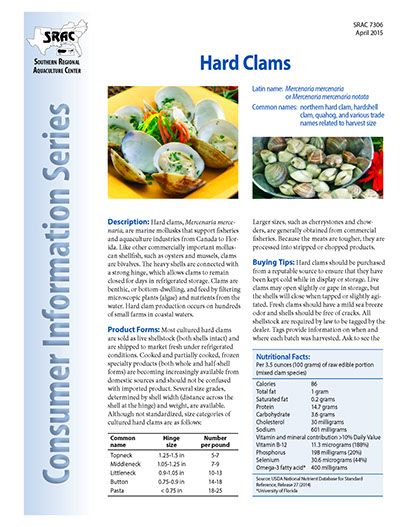Try Some





Latin name: Mercenaria mercenaria or Mercenaria mercenaria notata
Common names:
Northern Hard Clam, Hardshell Clam, Quahog and various trade names related to harvest size.
Product Forms:
Most cultured hard clams are sold as live shellstock (both shells intact) and are shipped fresh under refrigerated conditions to markets. Cooked and partially cooked, frozen specialty products (both whole and half-shell forms) are becoming increasingly available domestically and should not be confused with imported product.
Several size grades, determined by shell width (distance across the hinge) and weight, are available. Although not standardized, size categories of cultured hard clams are as follows:
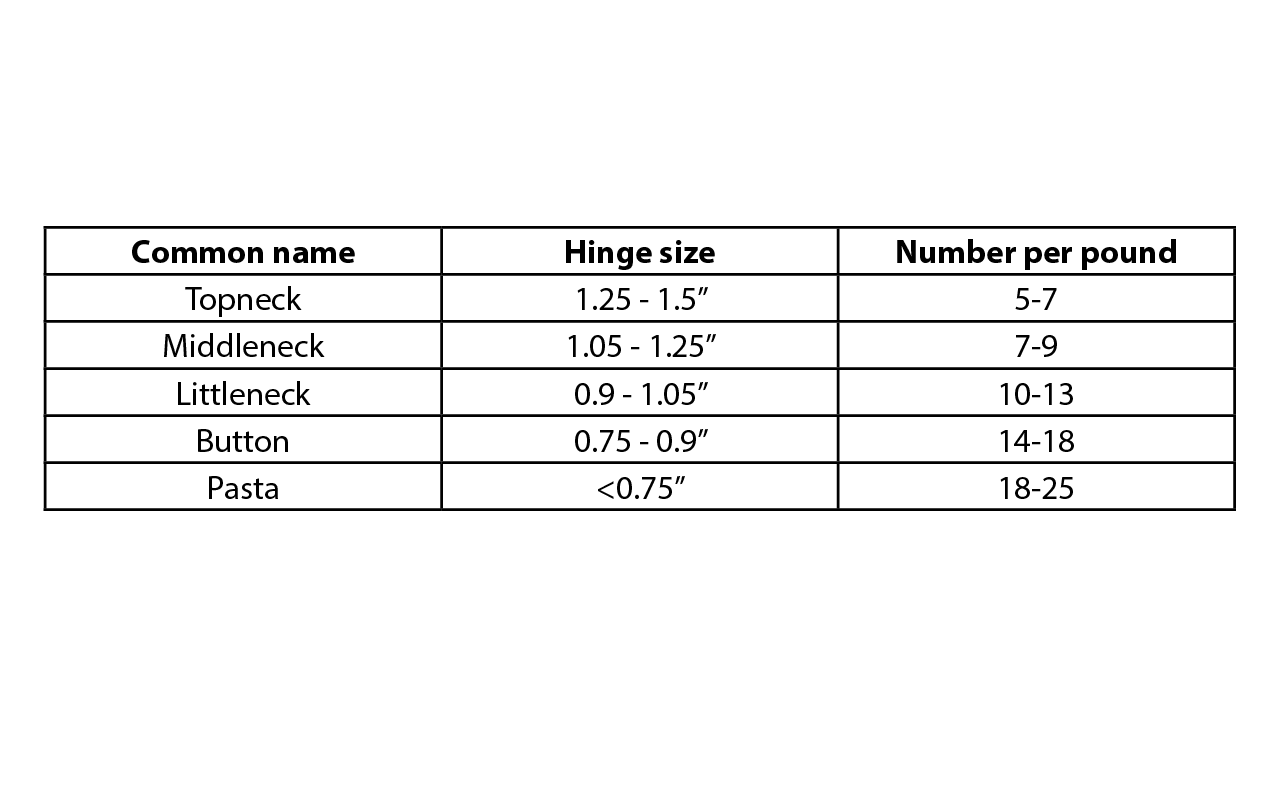
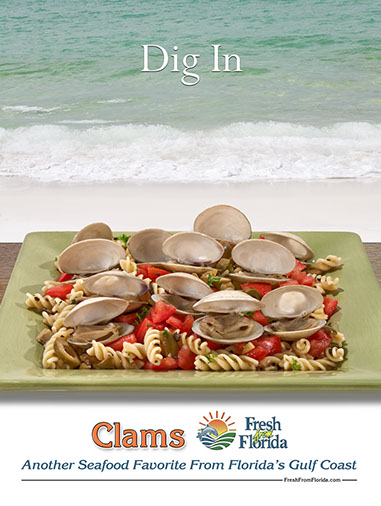
Buying Tips:
Hard clams should be purchased from a reputable source to ensure they have been kept cold while in display or storage prior to sale. Live clams may open slightly or gape in storage but the shells will close when tapped or slightly agitated. Fresh clams should have a mild sea breeze odor, and shells should be free of cracks. All shellstock are required by law to be tagged by the dealer which provides information on when and where each batch was harvested; ask to see the tag to confirm the source. Purchase clams last and transport home in a cooler with ice or cold packs.
Storing Tips:
Fresh clams will remain alive for several days at home if properly handled and kept refrigerated at 40 to 45°F. Do not place live clams directly on ice or immerse in water, rather store them in a ventilated container. Drain excess liquid daily and discard clams if they do not close. Clams in the shell and shucked meats can be frozen and kept up to 3 months in a home freezer. To freeze place in a heavy freezer bag, push out excess air, and seal. Clams in the shell can be used directly from the freezer; however, frozen clam meats should be thawed in the refrigerator prior to cooking.
Preparation Tips:
Prior to cooking, rinse clams under cold running water to remove residual sand or grit. Clams are easy to prepare and delicious when steamed, grilled, roasted, or cooked in the microwave. Cooking times will vary according to size and recipe; however, when the shell completely opens the clam is ready to eat. Littlenecks are often served raw on the half-shell.
To “shuck” (open) a live clam, hold it flat on the palm of one hand with the shell hinge against the palm. Insert a “clam knife” between the shell halves at the front of the clam, twisting the knife slightly to pry open and then cutting through the two muscles from one shell for half-shell recipes, or from both shells to obtain the meat. It is easier to shuck clams after they have been placed on ice.
State and federal regulatory authorities have programs in place to ensure that live molluscan shellfish are safe to eat, but high risk individuals with a compromised immune system should not eat raw or undercooked clams. For further information, please read this information. Times for fully cooked product are recommended by the U.S. Food and Drug Administration.
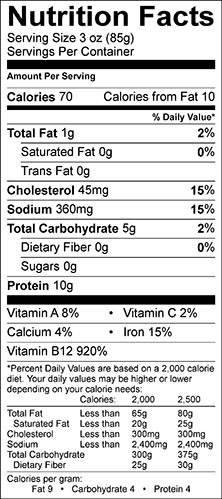
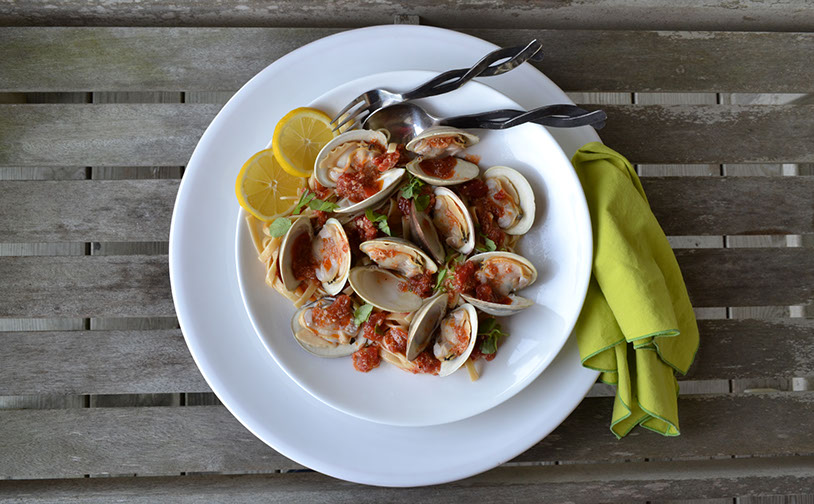
Hard clams are a low fat source of protein. A serving of 3 ounces (85 grams) of raw, edible portion is about 18 littleneck-sized clams – maybe too many for some, but for clam lovers that is not enough! This serving size provides approximately 10 grams (g) of protein. The low fat content (1 gram) is composed primarily of polyunsaturated fat (54%) and saturated fat (28%). The level of cholesterol is about 45 milligrams (mg) per serving. This level is lower than other sources of protein, such as beef, pork, chicken, and eggs.
An important nutritional feature of hard clams is that a single serving (3 oz) provides 0.4 grams of omega-3 fatty acids (over 80% of the polyunsaturated fat content). Omega-3 fatty acids are considered essential fatty acids as they are necessary for human health but the body can’t make them. They can be found in fish and other seafood, such as shellfish. Omega-3 fatty acids play a crucial role in brain function, as well as normal growth and development.
Another important nutritional feature of hard clams is that they provide a good complement of minerals and vitamins.
A serving size (3 oz) of hard clams also provides:
- 920% of the daily requirement of Vitamin B12. With clams, consumers receive a high
- percentage of this vitamin without having to consume a lot of calories (actually only 70).
- 8% of the daily requirement of Vitamin A and 2% of the daily requirement of Vitamin C.
- 15% of the daily requirement of Iron.
- 4% of the daily requirement of Calcium.
The sodium content of mollusks, such as clams and oysters, can range from undetectable to as high as 500 mg per 85 g of meat. The level depends on the salinity of the water in the growing area at the time of harvest. On average, hard clams have a sodium content of 360 mg per serving.
Sensory profiling is a science used to describe food products for attributes that could influence consumer acceptance and market values. A sensory evaluation of Florida hard clams was conducted by a trained seafood sensory panel at the University of Florida (UF), Aquatic Food Products Lab to describe, or profile, the characteristics of this seafood product.
Results of the UF Sensory Evaluation of Hard Clams:
- Outer shell color for hard clams can range from common grey and whitish-tones to more browns and some orange coloration. The minerals in the clam’s growing environment and substrate characteristics contribute to these variations in shell colors.
- An attractive external feature is a reddish-colored striated pattern, referred to as “notata” markings. This pattern is selected during the hatchery production of seed to distinguish cultured product from wild harvested clams.
- The edible meat is lighter in color, typically beige with peach and pink tones when raw and predominately beige-tan when cooked. The meat volume (for example, fill in the half-shell) can vary seasonally but typically is pump year-round as growing conditions in Florida provide abundant natural food for shellfish.
- Fresh hard clams smell like an ocean breeze, somewhat briny with a slight metallic aroma. In terms of taste, “salty” is a distinguishing attribute since clams are filter feeders and are grown in high salinity waters.
- There is an interesting rating for umami taste, which has not been previously described for hard clams. Umami is a term borrowed from the Japanese, meaning “good” or “pleasant” taste. Scientists describe this fifth basic taste as brothy, meaty or savory.
- The saltiness of hard clams tends to mask other flavor attributes. Texture ratings of clams are characteristically firm and sometimes chewy.
- Sensory Profile -
Florida Cultured Hard Clams
Appearance:
Plump, predominantly light colored meat, beige with pink and peach tones
Aroma:
Moderate briny and slight metallic aroma
Basic Taste:
Salty, with slight umami
Flavors and Aftertastes:
Seaweed and earthy accompanied
by a slightly astringent aftertaste
Textures:
Lean meat with firm texture
The following recipes are simple to prepare at home and feature Florida farm-raised clams. These easy-to-follow recipes are provided by the Florida Department of Agriculture and Consumer Services (DACS), Bureau of Seafood and Aquaculture Marketing. You can print a copy using the link at the end of the recipes. For more recipes and preparations tips, download the DACS informational brochure or visit their website.
For the recipe for Florida Clams with Andouille Sausage & Plum Tomatoes, click here. Chef Peter Stefani, of the Island Room in Cedar Key, debuted it at Romancing The Clam 2009, in Savannah, Georgia to rave reviews.
13 Clam Recipes to Make You Happy as a You-Know-What were recently featured on Food52.com in August 2015. Which recipe will be your favorite?
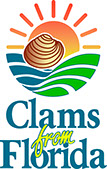
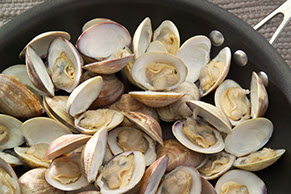
Steamed Clams
Ingredients:
2 dozen littleneck clams
1 cup dry sherry
1/2 cup green onions, chopped
2 teaspoons garlic, chopped
2 teaspoons fresh ginger, chopped
Directions:
Wash clams thoroughly under cold running water and set aside.
Place all ingredients except clams in a large sauce pan. Simmer on medium heat for 3 minutes; add clams and cover.
Simmer until clams open; remove clams to a large bowl.
Simmer remaining liquid until it is reduced to 3/4 cup. Pour liquid over clams and serve.
Serves 4.
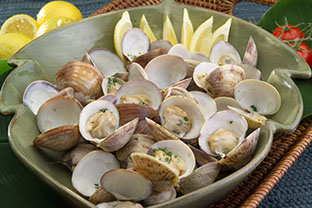
Oven Roasted Clams & Herb Butter
Ingredients:
4 dozen littleneck clams, rinsed well
4 tablespoons butter
2 tablespoons olive oil
1/2 cup white wine
3 cloves garlic, minced
2 tablespoons fresh parsley, chopped
1/2 teaspoon fresh oregano, chopped
Directions:
Preheat oven to 350 degrees F. Place clams in a baking pan with sides on middle rack of oven. Roast for approximately 10 minutes checking every few minutes for clams that have popped open.
Carefully remove open clams to a serving dish, reserving juices in shell. Keep warm.
While clams roast, melt butter in medium pan. Add olive oil, wine, garlic, parsley and oregano and bring to simmer. Spoon herb butter over cooked clams and serve.
Serves 4.
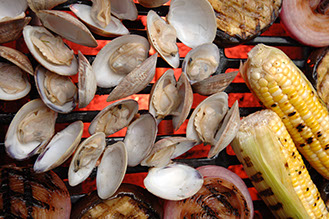
Easy Grilled Clams
Ingredients:
2 to 4 dozen littleneck clams, rinsed well
Vinegar Sauce:
1/2 cup cider vinegar
1 teaspoon garlic, minced
1/2 cup green onions, finely chopped
1 teaspoon salt
1 teaspoon black pepper, fresh ground
1/4 cup tomatoes, finely chopped
Directions:
Place clams on grill about 4 inches from coals or gas flame. Close cover and roast for approximately 10 minutes or until clam shells open. Check every few minutes for clams that have popped open. Carefully remove the open clams to an aluminum pan, reserving juices in shell. Serve clams in shells with melted garlic butter or vinegar sauce.
For the vinegar sauce, combine ingredients in small bowl and serve as dipping sauce for cooked clams.
Serves 4.
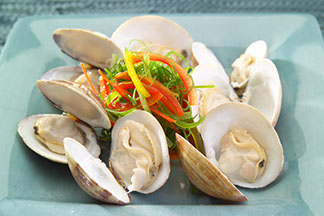
Wine-Steamed Clams
Ingredients:
2 dozen littleneck clams, rinsed well
2 cups white wine
1 small red onion, sliced
2 tablespoons garlic, chopped
2 teaspoons fresh ginger, chopped
1 tablespoon fresh cilantro, chopped
2 bay leaves
1 teaspoon whole black peppercorns
1/4 cup butter
1/4 cup lemon juice
Directions:
Place all ingredients except clams in a large sauce pan. Simmer on medium heat for 3 minutes; add clams and cover.
Simmer until clams open, stirring frequently.
Serves 4.

